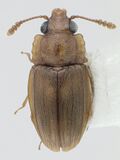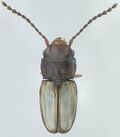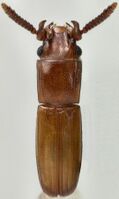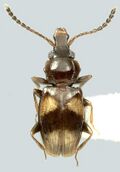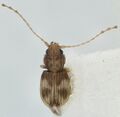Biology:Laemophloeidae
| Laemophloeidae | |
|---|---|

| |
| Laemophloeus germaini | |
| Scientific classification | |
| Domain: | Eukaryota |
| Kingdom: | Animalia |
| Phylum: | Arthropoda |
| Class: | Insecta |
| Order: | Coleoptera |
| Suborder: | Polyphaga |
| Infraorder: | Cucujiformia |
| Superfamily: | Cucujoidea |
| Family: | Laemophloeidae Ganglbauer, 1899 |
| Genera | |
|
Acompsophloeus Thomas, 2010 | |
Laemophloeidae, "lined flat bark beetles," is a family in the superfamily Cucujoidea characterized by predominantly dorso-ventrally compressed bodies, head and pronotal discs bordered by ridges or grooves, and inverted male genitalia.[1][2] Size range of adults is 1–5 mm (0.04–0.2 in) in length. Currently, it contains 40 genera and about 450 species,[3] and is represented on all continents except Antarctica; species richness is greatest in the tropics.
Classicification
Historically, Laemophloeidae was treated as a subfamily of Cucujidae, but starting in the middle of the 20th century,[4] most of what had been treated as subfamilies of the Cucujidae were considered to be families.
Habitat and behaviour
Most laemophloeids, adults and larvae, are found under bark of dead trees, where they apparently are primarily fungivores,[5] although some genera with adults having subcylindrical bodies (e.g., Leptophloeus, Dysmerus) occur in the galleries of bark beetles (Curculionidae: Scolytinae), upon which they may feed.[6] A few genera, but most particularly Cryptolestes, contain some species that are pests of stored grain products. The most important of these are Cryptolestes ferrugineus (Stephens), Cryptolestes pusillus (Schönherr), and Cryptolestes turcicus (Grouvelle).[7]
Characteristics
Several genera exhibit unusual modifications to male antennae (especially Cryptolestes, Dysmerus, and Microbrontes), with the scape expanded into hook-like or blade-like structures.[8][9] Several other genera (Rhinomalus, Rhinophloeus, and Metaxyphloeus) related to Laemophloeus are atypical in that the adults are rostrate to varying degrees.[10] Photographs of most world genera are available at,[11] and most North American species are pictured at:[12]
Leaping larvae
According to an article published by PLOS ONE, a discovery has been made regarding the larvae of laemophloeidae. Studies show that when the larvae is in the open, the larvae will straighten themselves out and jump curling up into a ball in the process. It has also been discovered that the larvae can bounce when they are curled up.[13][14]
Gallery
Odontophloeus sp.
References
- ↑ "Family 83. Laemophloeidae Ganglbauer 1899.". American Beetles. Volume 2: Polyphaga: Scarabaeoidea through Curculionoidea.. Boca Raton: CRC Press. 2002. pp. 331–334. xiv + 861pp.
- ↑ "Laemophloeidae, Ganglbauer, 1899.". Handbook of Zoology. Coleoptera, Beetles. Volume 2: Morphology and Systematics (Elateroidea, Bostrichiformia, Cucujiformia partim).. Berlin: Walter de Gruyter. 2010. pp. 376–380.
- ↑ "Laemophloeidae Species List". Joel Hallan’s Biology Catalog.. Texas A&M University. http://insects.tamu.edu/research/collection/hallan/Arthropoda/Insects/Coleoptera/Family/Laemophloeidae.txt.
- ↑ The natural classification of the families of Coleoptera.. London: Nathaniel Lloyd. 1955. pp. 187.
- ↑ "Coleoptera associated with an Hypoxylon species (Ascomycetes: Xylariaceae) on oak.". The Coleopterists' Bulletin 31 (4): 309–312. December 1977.
- ↑ "The flat bark beetles of Florida (Laemophloeidae, Passandridae, Silvanidae).". Arthropods of Florida and Neighboring Land Areas. 15. Florida Department of Agriculture and Consumer Services, Division of Plant Industry. 1993. pp. i-viii and 1–93.
- ↑ "Keys for the identification of beetles associated with stored products—II. Laemophloeidae, Passandridae and Silvanidae.". Journal of Stored Products Research. 29 (2): 99–197. June 1993. doi:10.1016/0022-474X(93)90030-8.
- ↑ "Unusual antennal characters in some Laemophloeinae (Coleoptera: Cucujidae) and their taxonomic importance.". Proceedings of the Royal Entomological Society of London. Series B, Taxonomy (Oxford, UK: Blackwell Publishing Ltd.) 27 (5–6): 93–100. July 1958. doi:10.1111/j.1365-3113.1958.tb00419.x.
- ↑ "A review of the genus Dysmerus Casey (Coleoptera: Laemophloeidae).". Insecta Mundi 74: 1–30. May 2009. https://digitalcommons.unl.edu/cgi/viewcontent.cgi?article=1601&context=insectamundi.
- ↑ "A new Neotropical genus and species of rostrate Laemophloeinae (Coleoptera: Cucujidae) with discussion of the systematic position of the subfamily.". The Coleopterists' Bulletin. 38 (1): 67–83. March 1984.
- ↑ "Photographic Atlas of Laemophloeid Genera". Florida State Collection of Arthropods. http://www.fsca-dpi.org/Coleoptera2/Mike/LaemophloeidaeLink.html.
- ↑ "Laemophloeidae of Florida". Florida State Collection of Arthropods. http://www.fsca-dpi.org/Coleoptera2/Mike/FloridaLaemophloeidae/LaemophloeidaeofFlorida.htm.
- ↑ "These Beetles Go Boing" (in en-US). https://www.sciencefriday.com/segments/jumping-beetles/.
- ↑ "A novel power-amplified jumping behavior in larval beetles (Coleoptera: Laemophloeidae)". PLOS ONE 17 (1): e0256509. 2022-01-19. doi:10.1371/journal.pone.0256509. PMID 35045081.
Wikidata ☰ Q1040629 entry
 |
